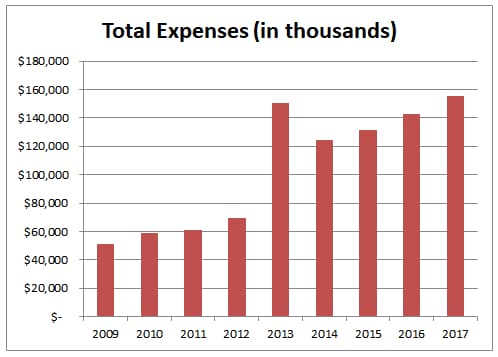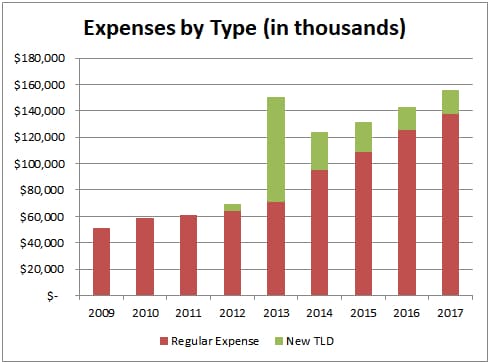A look at data behind ICANN’s growth and ensuing budget crunch.
ICANN is in a bit of a budget crunch. Lower than expected revenues along with a re-evaluation of the required reserve fund (and tapping into it) are straining the organization.
I have plenty of thoughts on how this happened and what to do about it, but I’m going to start with a series of charts showing the size of ICANN over the past 7-8 years.
Let’s start by looking at the non-profit’s expenses over the years.
Note that ICANN’s fiscal year ends in June. For example, its 2016 financial year ended June 2016, and data from that year was reported on its 2015 tax return.
This chart shows total expenses for FY 2009 to FY 2017. Data is taken from tax returns except for 2017, which is taken from audited financial statements.

You’ll notice a huge jump in FY 2013 as ICANN scaled up to evaluate new top level domain name applications. This was a heavy-lifting year for ICANN. While ICANN’s expenses swelled from $70 million to $150 million, all but $7 million of the difference was attributed to new TLDs. (I’m counting operational new TLD costs and risk expenses, but not financial investment expenses.)
And this is where things get interesting. In the next year, FY 2014, ICANN’s allocated expenses for new TLDs dropped by $50 million but its overall expenses fell by only $26 million.
Here’s a stacked chart showing each year’s expenses divided between regular and new TLD.

See a problem?
In my next post, we’ll look at headcount at the organization.






It’s like any company. It over-expanded and it needs to shrink or increase revenue. C’mon round 2!
ICANN likes to be spending more and more and when there is no “growth” then they complain. They complain when they should have been spending half of what they do! They have become a blood-sucking vampire eating away our money and thinking they are actually doing something to deserve that money.
@Bob. Yes, only problem is that it is not a company. They have contributed nothing to this “growth”.
Now they have us in the middle of a shit-storm with no GDPR plan, traveling around the world searching for volunteers to do their work.
Finally, they saw the GDPR and halted thick whois for .com and .net while thick whois is the only thing that can help with GDPR.
Pathetic.
Actually, thin WHOIS looks like a GDPR solution…
I disagree and the thing is that thick whois is coming anyway. ICANN will be crying all over again when thick whois comes in a year or two.
I have a clear solution in my mind for GDPR. One that can be easily implemented. I am not saying I will like it 100% but I don’t like GDPR but it will become a reality.
My solution has been partly implemented by a couple of registries so a few people are familiar with it…
Thick whois is not coming. Registrars already hated the idea and were planning to send dummy data to the registry anyways; GDPR appeared and now there are legal reasons to not send the data.
The policy that dictated this migration is dead in the water, and will be replaced by the output of the RDS PDP. And the real reasoning for the thick WHOIS migration, RDDS standardisation, will be achieved before that.
Thick whois is not coming???
It is already here for 99% of the registries. Only .com and .net don’t have thick whois.
Clearly Icann have expenses that are out of control. Domain growth has been slowing for years and the ntlds are likely to see long term shrinkage in my view.
At some point they will need to make very drastic cuts if they don’t make some substantial changes now. It is entirely possible that Icann could have falling revenue within 5 years. They need to “think smaller”.
Good analysis. What we’re seeing now is the result of years of expense growth driven by community pressure for ICANN to expand its scope, coupled with leadership that’s been unwilling/unable to say “No.”